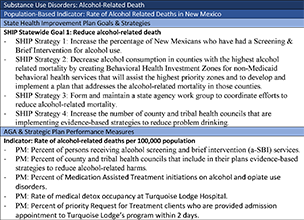Performance Management System
Performance Management History
In 1999, when New Mexico passed the Accountability in Government Act (AGA), it began a system where state agencies’ budgets were tied to performance data and it developed regular accountability functions via progress reporting to the state legislature and the executive branch. Therefore, the New Mexico Department of Health’s (NMDOH) Performance Management System (PMS) has long-term historical roots in performance management because of the AGA.
Annual performance measures are determined through multiple factors:
- The potential program contribution made to either population health or programmatic activities.
- The connection to the State Health Improvement Plan’s priorities and/or the departmental strategic plan.
- The future funding strategies and policy directions of the department.
- The Governor and/or legislative, as well as public, issue areas that need addressing.
Since enactment of the AGA, NMDOH has developed, monitored, and reported on numerous performance measures. The NMDOH Performance Management System began to develop around 2011 and matured with the Department’s efforts to gain national public health accreditation. With national Public Health Accreditation in 2015, NMDOH moved away from measuring and reporting on program performance strictly as a budgetary or compliance endeavor and began viewing the measurement and reporting of performance as a required activity.
NMDOH's Performance Management System
With an added push for organizational excellence from public health accreditation, NMDOH institutionalized a system of performance management and improvement. The Performance Management System (PMS) is an agency-wide design that has its foundation in a commitment to excellence and a belief that active governance is an effective way to ensure and improve performance, as well as improve health status and outcomes for the state of New Mexico. Further, the PMS conveys an essential linkage between program performance and population health status improvement.
To understand the PMS, it is important to differentiate between measures of health, which NMDOH calls “indicators”, and measures of performance on health, which are called “performance measures". There are three levels of performance accountability and measure setting:
- Population health status indicators;
- Statewide health strategies; and
- Program performance measures.

Population Health Status Indicators:
At the population level, a desired condition of well-being for the population is identified and indicators are used to measure population health status. With the indicators, in order to achieve the desired condition of well-being, the entire health system has to work collectively to improve New Mexico’s overall health status.
Statewide Health Strategies:
The State Health Improvement Plan (SHIP) functions as a statewide health strategic plan and proposes statewide health strategies, whereby the collective health system should work in alignment toward the desired population-based indicator’s improvement.
Program Performance Measures:
At the NMDOH program level, programs determine performance measures, thereby reflecting their particular contribution to overall health status and how they can be accountable for their program’s performance.
OPA’s Performance Management Coordination
The Department’s Office of Policy and Accountability (OPA) serves as an administrative hub for the operation of the Department’s Performance Management System. OPA provides training and oversight in the development of performance measures and reports on progress. Within each of the Department’s eight divisions, Performance Management Coordinators (PMCs) organize their division’s performance management work and help integrate and diffuse performance management throughout the Department.
All New Mexico state agencies report annually on their AGA measures as part of the budget proposal and performance management process. This process also identifies “key” agencies, which are those with large mandates and budgetary responsibility, to report on their performance quarterly, and NMDOH is a key agency with quarterly reporting expectations.
You can read and review our quarterly reports here: Performance Management System Publications
Where progress is not occurring as anticipated, the PMS incorporates the use of Quality Improvement to accelerate progress. The benefits of the system include:
- Opportunities to build upon existing systems, priorities, agency initiatives, and strategic goals.
- Transparency created by setting objectives and establishing metrics for those objectives.
- Improved decision-making for resource allocation.
- Prioritization around a common set of priorities and ways to measure progress.
OPA compiles the quarterly reports from the PMCs, submits the reports to the legislative and executive bodies of government, works within the department to assess performance progress, and provides QI technical assistance and coordination in order to incentivize an overall system of improvement.

